This is a Dutch word to describe what they are now doing on the foundation work. If I look up the word in an online dictionary, it says ‘recess’, but I don’t think that’s quite right. Anyone have a better translation?
Anyway, in the picture above, you can see they have made some holes in bottom of the wall, 50cm every 50cm to be exact. They will make these holes all the way around the house, and in each one put a jack like you see above. In this way, half the house will be supported by means of a jack.
In foundation repairs jacks are always used. This is because you somehow have to move the weight of the house from the old foundation to the new one, and jacks are always needed in some way. I think the way they will do it with my house is a little unusual however.
What will happen is they will pour a new concrete floor and entomb the jacks, as well as fill the spaces in the walls. The concrete floor will have a complex reinforcing structure, and will be supported by the piles that were driven earlier. The new foundation will then be in place, and capable of supporting the house.
Over time, the old foundation will continue to degrade and sink, and in this way the weight will gradually be taken up by the new foundation. The construction engineer mentioned he included in his calculations that the old foundation will continue to provide a degree of support for the house into the future.





